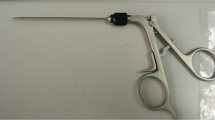Abstract
Purpose
Several single-port laparoscopic hernial repair methods have been designed to treat inguinal hernia in children, but reliable and safe ligation of the hernial sac should be further investigated. This study aimed to investigate a new technique for laparoscopic percutaneous double ligation for pediatric inguinal hernias with a set of home-made instruments.
Methods
Before each operation, a set of home-made instruments were prepared, including a curved puncture needle, a lasso suture, a dual ligation suture, and occasionally, a flat-headed puncture needle for obese patients. After a series of operational steps, the hernial sac was doubly extracorporeally ligated, leaving only one puncture point in the inguinal region and one incision in the navel.
Results
Between October 2011 and September 2013, 236 children (211 boys and 25 girls) underwent hernial repair using this novel technique. In 38.8 % (85/219) of patients with the preoperative diagnosis of unilateral inguinal hernia, contralateral patent processus vaginalis was confirmed during the laparoscopic surgery and subsequent repair was performed. In 134 cases of unilateral repair, the mean operative time was 11 min (range 5–16 min), and it was 19 min (range 13–29 min) in 102 cases of bilateral repair. No recurrence or complications have been observed to date.
Conclusions
This study shows a unique technique of percutaneous double ligation of the hernial sac using a minimally invasive technique with the aid of a transabdominal 5-mm telescope and a set of home-made instruments. Single-port laparoscopic hernial repair using this technique is feasible and appears to be safe.




Similar content being viewed by others
References
Bharathi RS, Arora M, Baskaran V (2008) Minimal access surgery of pediatric inguinal hernias: a review. Surg Endosc 22:1751–1762
Chang YT (2010) Technical refinements in single port laparoscopic surgery of inguinal hernia in infants and children. Diagn Ther Endosc 2010:392847
Harrison MR, Lee H, Albanese CT, Farmer DL (2005) Subcutaneous endoscopically assisted ligation (SEAL) of the internal ring for repair of inguinal hernias in children: a novel technique. J Pediatr Surg 40:1177–1180
Ozgediz D, Roayaie K, Lee H et al (2007) Subcutaneous endoscopically assisted ligation (SEAL) of the internal ring for repair of inguinal hernias in children: report of a new technique and early results. Surg Endosc 21:1327–1331
Patkowski D, Czernik J, Chrzan R et al (2006) Percutaneous internal ring suturing: a simple minimally invasive technique for inguinal hernia repair in children. J Laparoendosc Adv Surg Tech 16:513–517
Chang YT, Wang JY, Lee JY et al (2008) One-trocar laparoscopic transperitoneal closure of inguinal hernia in children. World J Surg 32:2459–2463
Chang YT, Wang JY, Lee JY, Chiou CS (2009) A simple single-port laparoscopic-assisted technique for completely enclosing inguinal hernia in children. Am J Surg 198(1):e13–e16
Li B, Nie X, Xie H, Gong D (2012) Modified single-port laparoscopic herniorrhaphy for pediatric inguinal hernias: based on 1,107 cases in China. Surg Endosc 26(12):3663–3668
Liu W, Wu R, Du G (2014) Single-port laparoscopic extraperitoneal repair of pediatric inguinal hernias and hydroceles by using modified Kirschner pin: a novel technique. Hernia 18(3):345–349
Tsai YC, Wu CC, Yang SS (2007) Minilaparoscopic herniorrhaphy with hernia sac transection in children and young adults: a preliminary report. Surg Endosc 21:1623–1625
Chan KL, Chan HY, Tam PK (2007) Towards a near-zero recurrence rate in laparoscopic inguinal hernia repair for pediatric patients of all ages. J Pediatr Surg 42:1993–1997
Tatekawa Y (2012) Laparoscopic extracorporeal ligation of hernia defects using an epidural needle and preperitoneal hydrodissection. J Endourol 26(5):474–477
Author information
Authors and Affiliations
Corresponding author
Ethics declarations
Conflict of interest
Zhengmin Cui,Yu Liu, Wentong Zhang, and Futao Sun declare that they have no conflict of interest.
Rights and permissions
About this article
Cite this article
Cui, Z., Liu, Y., Zhang, W. et al. Single-port laparoscopic percutaneous double ligation for pediatric inguinal hernias: report of a new technique and early results. Hernia 20, 579–584 (2016). https://doi.org/10.1007/s10029-015-1404-3
Received:
Accepted:
Published:
Issue Date:
DOI: https://doi.org/10.1007/s10029-015-1404-3




